Master of Business Administration: Malaysia Economic Analysis
VerifiedAdded on 2022/08/19
|19
|4360
|16
Case Study
AI Summary
This case study provides an economic analysis of Malaysia, examining various macroeconomic indicators such as GDP growth, inflation, unemployment, interest rates, income tax, balance of trade, and labor productivity. The analysis reveals a gradual economic slowdown in Malaysia, prompting a discussion of the need for policies to stimulate economic growth and improve output. The study delves into the impact of these indicators, offering insights into the country's economic trajectory. The report recommends expansionary monetary and fiscal policies to address the economic challenges. The paper includes an examination of the influence of macroeconomic theories on the Malaysian economy, and the recommendations made are designed to enhance business processes. The study also reviews the country's economic performance over the last decade, highlighting critical factors that have impacted its economic growth, and it provides an overview of the country's key economic sectors.
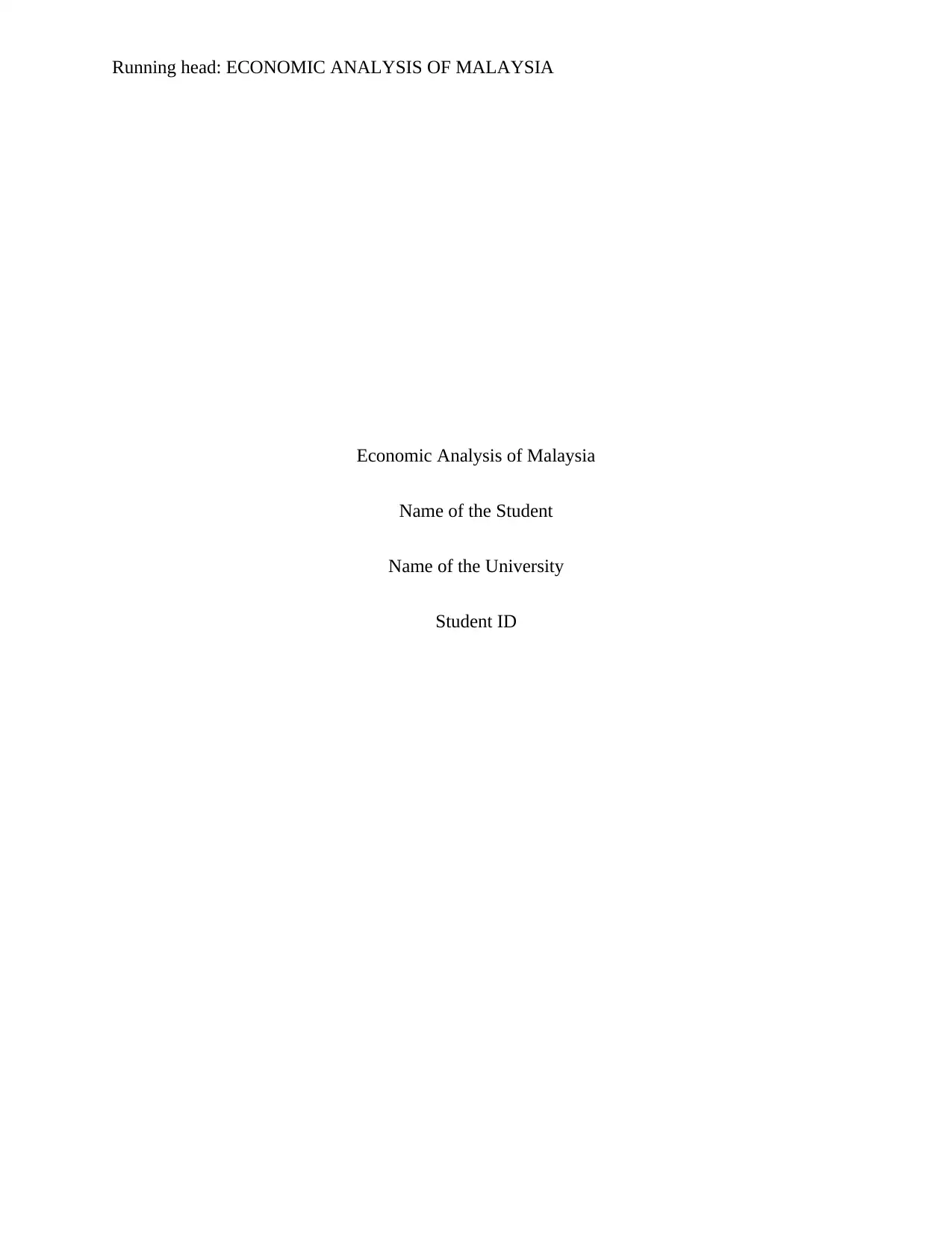
Running head: ECONOMIC ANALYSIS OF MALAYSIA
Economic Analysis of Malaysia
Name of the Student
Name of the University
Student ID
Economic Analysis of Malaysia
Name of the Student
Name of the University
Student ID
Paraphrase This Document
Need a fresh take? Get an instant paraphrase of this document with our AI Paraphraser
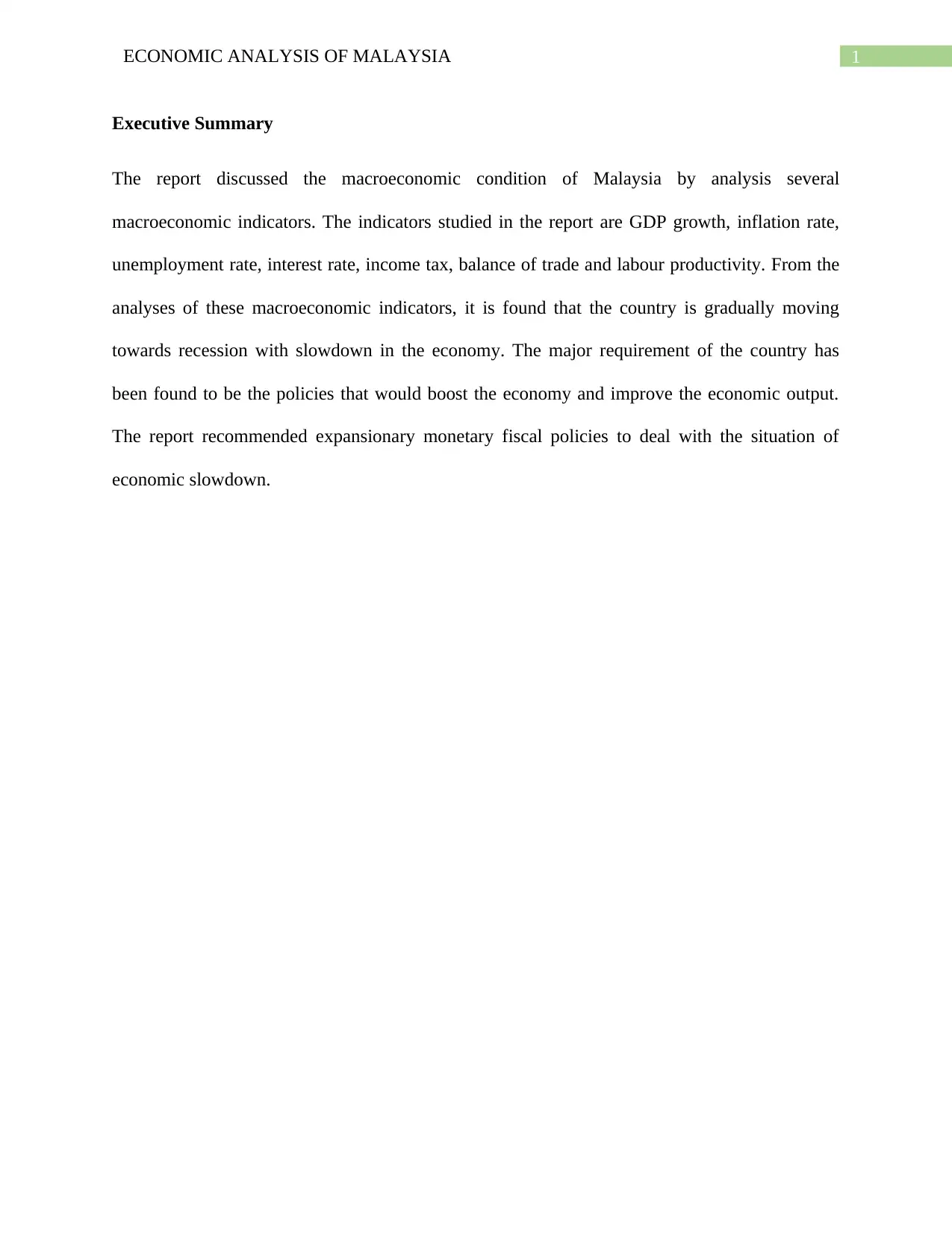
1ECONOMIC ANALYSIS OF MALAYSIA
Executive Summary
The report discussed the macroeconomic condition of Malaysia by analysis several
macroeconomic indicators. The indicators studied in the report are GDP growth, inflation rate,
unemployment rate, interest rate, income tax, balance of trade and labour productivity. From the
analyses of these macroeconomic indicators, it is found that the country is gradually moving
towards recession with slowdown in the economy. The major requirement of the country has
been found to be the policies that would boost the economy and improve the economic output.
The report recommended expansionary monetary fiscal policies to deal with the situation of
economic slowdown.
Executive Summary
The report discussed the macroeconomic condition of Malaysia by analysis several
macroeconomic indicators. The indicators studied in the report are GDP growth, inflation rate,
unemployment rate, interest rate, income tax, balance of trade and labour productivity. From the
analyses of these macroeconomic indicators, it is found that the country is gradually moving
towards recession with slowdown in the economy. The major requirement of the country has
been found to be the policies that would boost the economy and improve the economic output.
The report recommended expansionary monetary fiscal policies to deal with the situation of
economic slowdown.
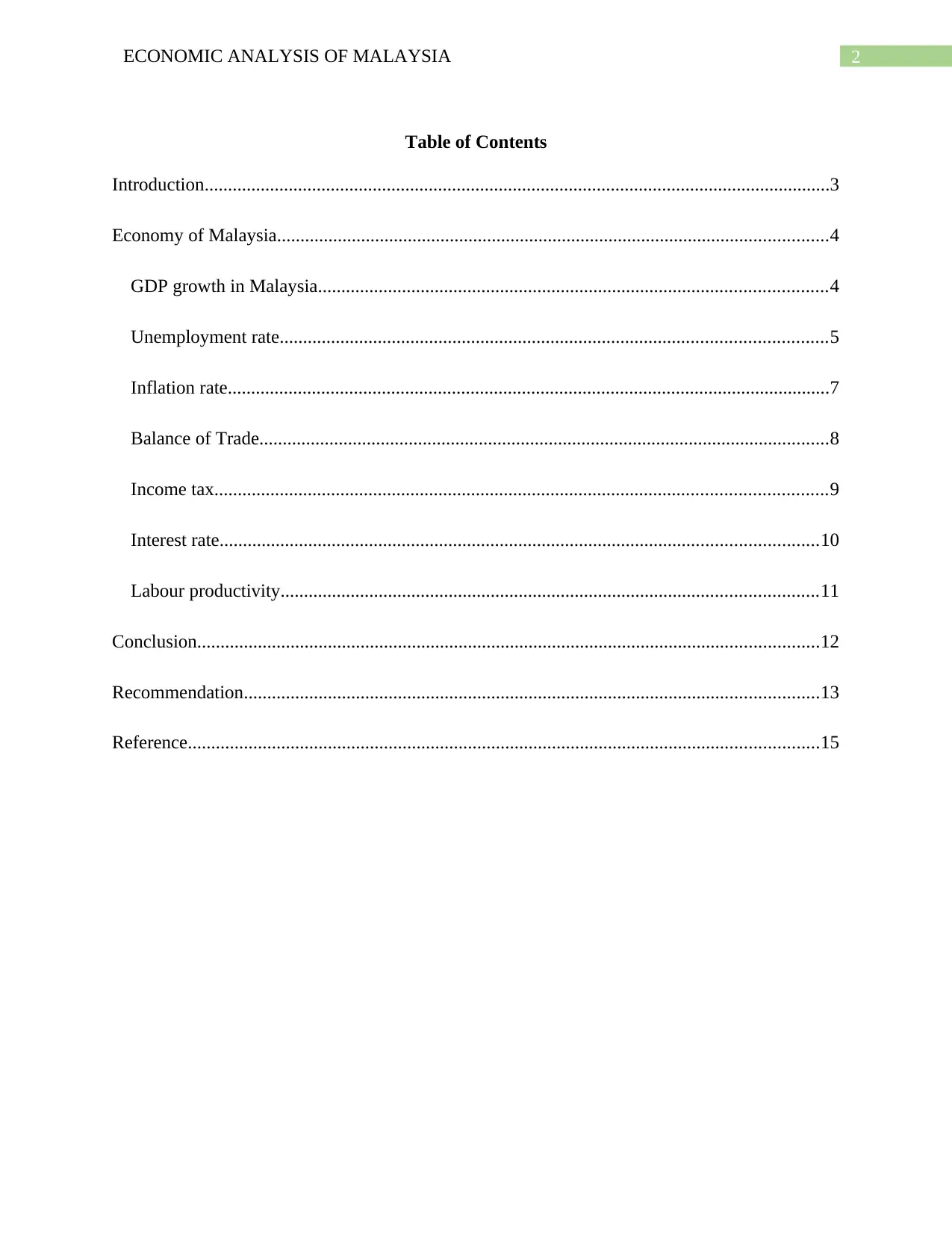
2ECONOMIC ANALYSIS OF MALAYSIA
Table of Contents
Introduction......................................................................................................................................3
Economy of Malaysia......................................................................................................................4
GDP growth in Malaysia.............................................................................................................4
Unemployment rate.....................................................................................................................5
Inflation rate.................................................................................................................................7
Balance of Trade..........................................................................................................................8
Income tax...................................................................................................................................9
Interest rate................................................................................................................................10
Labour productivity...................................................................................................................11
Conclusion.....................................................................................................................................12
Recommendation...........................................................................................................................13
Reference.......................................................................................................................................15
Table of Contents
Introduction......................................................................................................................................3
Economy of Malaysia......................................................................................................................4
GDP growth in Malaysia.............................................................................................................4
Unemployment rate.....................................................................................................................5
Inflation rate.................................................................................................................................7
Balance of Trade..........................................................................................................................8
Income tax...................................................................................................................................9
Interest rate................................................................................................................................10
Labour productivity...................................................................................................................11
Conclusion.....................................................................................................................................12
Recommendation...........................................................................................................................13
Reference.......................................................................................................................................15
⊘ This is a preview!⊘
Do you want full access?
Subscribe today to unlock all pages.

Trusted by 1+ million students worldwide
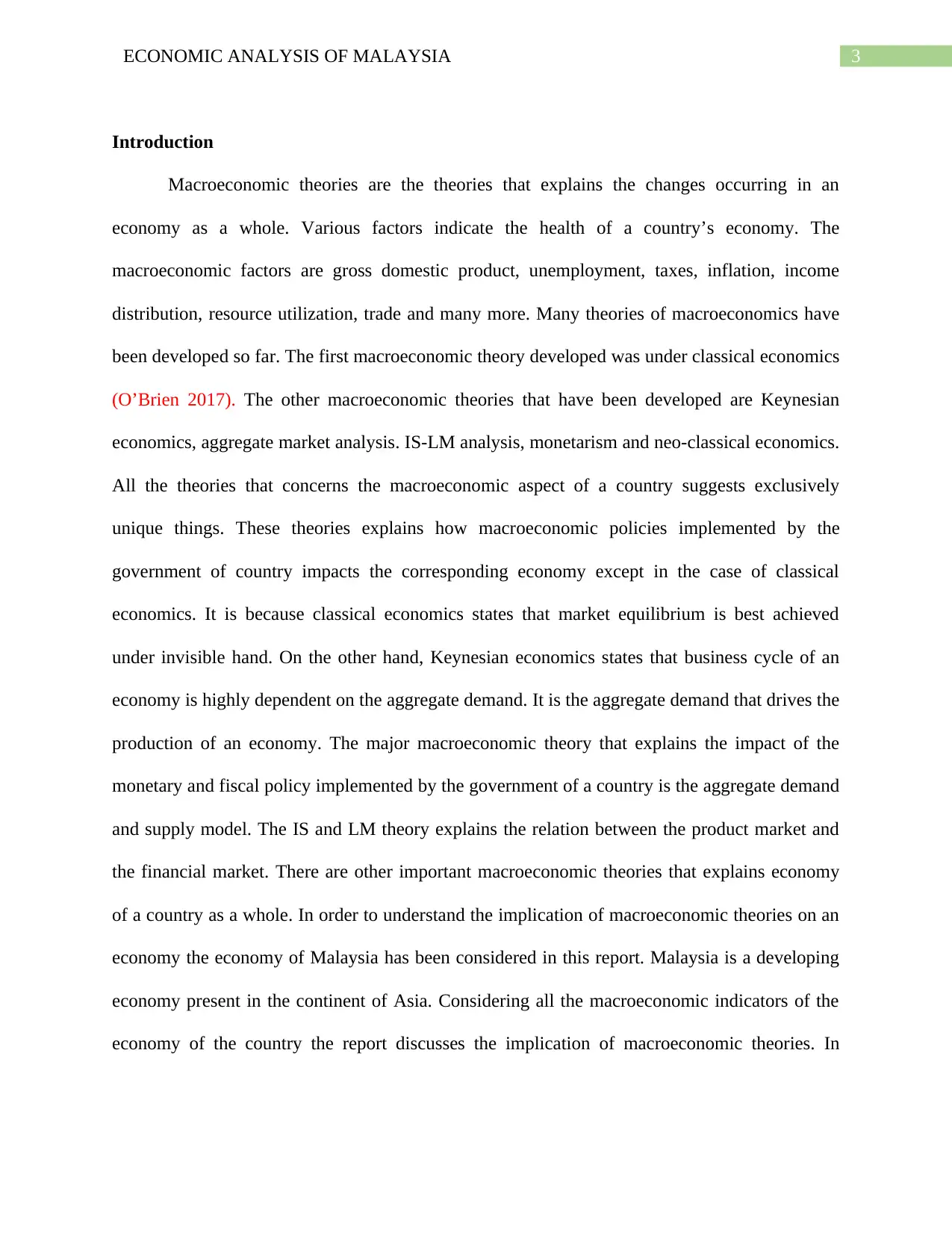
3ECONOMIC ANALYSIS OF MALAYSIA
Introduction
Macroeconomic theories are the theories that explains the changes occurring in an
economy as a whole. Various factors indicate the health of a country’s economy. The
macroeconomic factors are gross domestic product, unemployment, taxes, inflation, income
distribution, resource utilization, trade and many more. Many theories of macroeconomics have
been developed so far. The first macroeconomic theory developed was under classical economics
(O’Brien 2017). The other macroeconomic theories that have been developed are Keynesian
economics, aggregate market analysis. IS-LM analysis, monetarism and neo-classical economics.
All the theories that concerns the macroeconomic aspect of a country suggests exclusively
unique things. These theories explains how macroeconomic policies implemented by the
government of country impacts the corresponding economy except in the case of classical
economics. It is because classical economics states that market equilibrium is best achieved
under invisible hand. On the other hand, Keynesian economics states that business cycle of an
economy is highly dependent on the aggregate demand. It is the aggregate demand that drives the
production of an economy. The major macroeconomic theory that explains the impact of the
monetary and fiscal policy implemented by the government of a country is the aggregate demand
and supply model. The IS and LM theory explains the relation between the product market and
the financial market. There are other important macroeconomic theories that explains economy
of a country as a whole. In order to understand the implication of macroeconomic theories on an
economy the economy of Malaysia has been considered in this report. Malaysia is a developing
economy present in the continent of Asia. Considering all the macroeconomic indicators of the
economy of the country the report discusses the implication of macroeconomic theories. In
Introduction
Macroeconomic theories are the theories that explains the changes occurring in an
economy as a whole. Various factors indicate the health of a country’s economy. The
macroeconomic factors are gross domestic product, unemployment, taxes, inflation, income
distribution, resource utilization, trade and many more. Many theories of macroeconomics have
been developed so far. The first macroeconomic theory developed was under classical economics
(O’Brien 2017). The other macroeconomic theories that have been developed are Keynesian
economics, aggregate market analysis. IS-LM analysis, monetarism and neo-classical economics.
All the theories that concerns the macroeconomic aspect of a country suggests exclusively
unique things. These theories explains how macroeconomic policies implemented by the
government of country impacts the corresponding economy except in the case of classical
economics. It is because classical economics states that market equilibrium is best achieved
under invisible hand. On the other hand, Keynesian economics states that business cycle of an
economy is highly dependent on the aggregate demand. It is the aggregate demand that drives the
production of an economy. The major macroeconomic theory that explains the impact of the
monetary and fiscal policy implemented by the government of a country is the aggregate demand
and supply model. The IS and LM theory explains the relation between the product market and
the financial market. There are other important macroeconomic theories that explains economy
of a country as a whole. In order to understand the implication of macroeconomic theories on an
economy the economy of Malaysia has been considered in this report. Malaysia is a developing
economy present in the continent of Asia. Considering all the macroeconomic indicators of the
economy of the country the report discusses the implication of macroeconomic theories. In
Paraphrase This Document
Need a fresh take? Get an instant paraphrase of this document with our AI Paraphraser
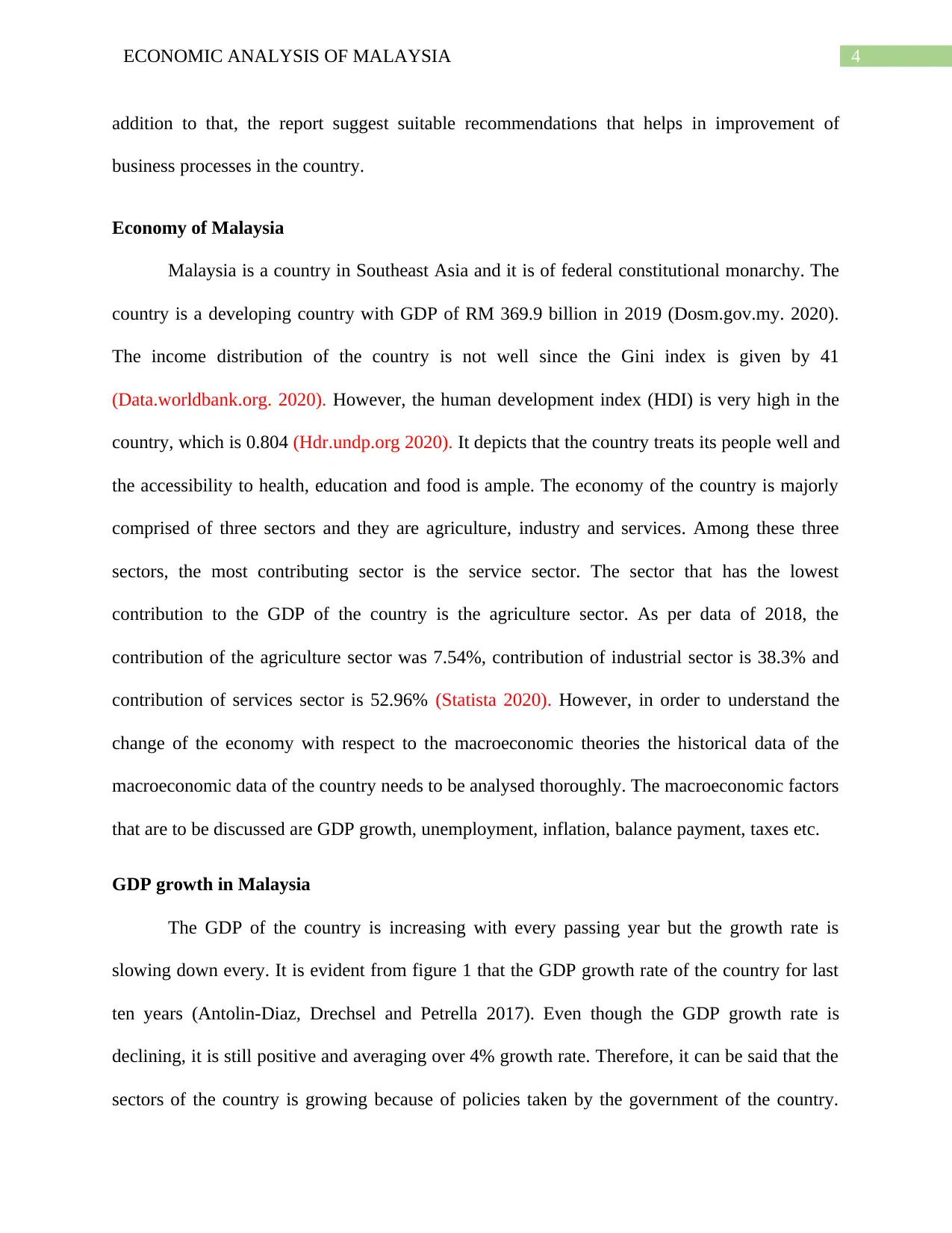
4ECONOMIC ANALYSIS OF MALAYSIA
addition to that, the report suggest suitable recommendations that helps in improvement of
business processes in the country.
Economy of Malaysia
Malaysia is a country in Southeast Asia and it is of federal constitutional monarchy. The
country is a developing country with GDP of RM 369.9 billion in 2019 (Dosm.gov.my. 2020).
The income distribution of the country is not well since the Gini index is given by 41
(Data.worldbank.org. 2020). However, the human development index (HDI) is very high in the
country, which is 0.804 (Hdr.undp.org 2020). It depicts that the country treats its people well and
the accessibility to health, education and food is ample. The economy of the country is majorly
comprised of three sectors and they are agriculture, industry and services. Among these three
sectors, the most contributing sector is the service sector. The sector that has the lowest
contribution to the GDP of the country is the agriculture sector. As per data of 2018, the
contribution of the agriculture sector was 7.54%, contribution of industrial sector is 38.3% and
contribution of services sector is 52.96% (Statista 2020). However, in order to understand the
change of the economy with respect to the macroeconomic theories the historical data of the
macroeconomic data of the country needs to be analysed thoroughly. The macroeconomic factors
that are to be discussed are GDP growth, unemployment, inflation, balance payment, taxes etc.
GDP growth in Malaysia
The GDP of the country is increasing with every passing year but the growth rate is
slowing down every. It is evident from figure 1 that the GDP growth rate of the country for last
ten years (Antolin-Diaz, Drechsel and Petrella 2017). Even though the GDP growth rate is
declining, it is still positive and averaging over 4% growth rate. Therefore, it can be said that the
sectors of the country is growing because of policies taken by the government of the country.
addition to that, the report suggest suitable recommendations that helps in improvement of
business processes in the country.
Economy of Malaysia
Malaysia is a country in Southeast Asia and it is of federal constitutional monarchy. The
country is a developing country with GDP of RM 369.9 billion in 2019 (Dosm.gov.my. 2020).
The income distribution of the country is not well since the Gini index is given by 41
(Data.worldbank.org. 2020). However, the human development index (HDI) is very high in the
country, which is 0.804 (Hdr.undp.org 2020). It depicts that the country treats its people well and
the accessibility to health, education and food is ample. The economy of the country is majorly
comprised of three sectors and they are agriculture, industry and services. Among these three
sectors, the most contributing sector is the service sector. The sector that has the lowest
contribution to the GDP of the country is the agriculture sector. As per data of 2018, the
contribution of the agriculture sector was 7.54%, contribution of industrial sector is 38.3% and
contribution of services sector is 52.96% (Statista 2020). However, in order to understand the
change of the economy with respect to the macroeconomic theories the historical data of the
macroeconomic data of the country needs to be analysed thoroughly. The macroeconomic factors
that are to be discussed are GDP growth, unemployment, inflation, balance payment, taxes etc.
GDP growth in Malaysia
The GDP of the country is increasing with every passing year but the growth rate is
slowing down every. It is evident from figure 1 that the GDP growth rate of the country for last
ten years (Antolin-Diaz, Drechsel and Petrella 2017). Even though the GDP growth rate is
declining, it is still positive and averaging over 4% growth rate. Therefore, it can be said that the
sectors of the country is growing because of policies taken by the government of the country.
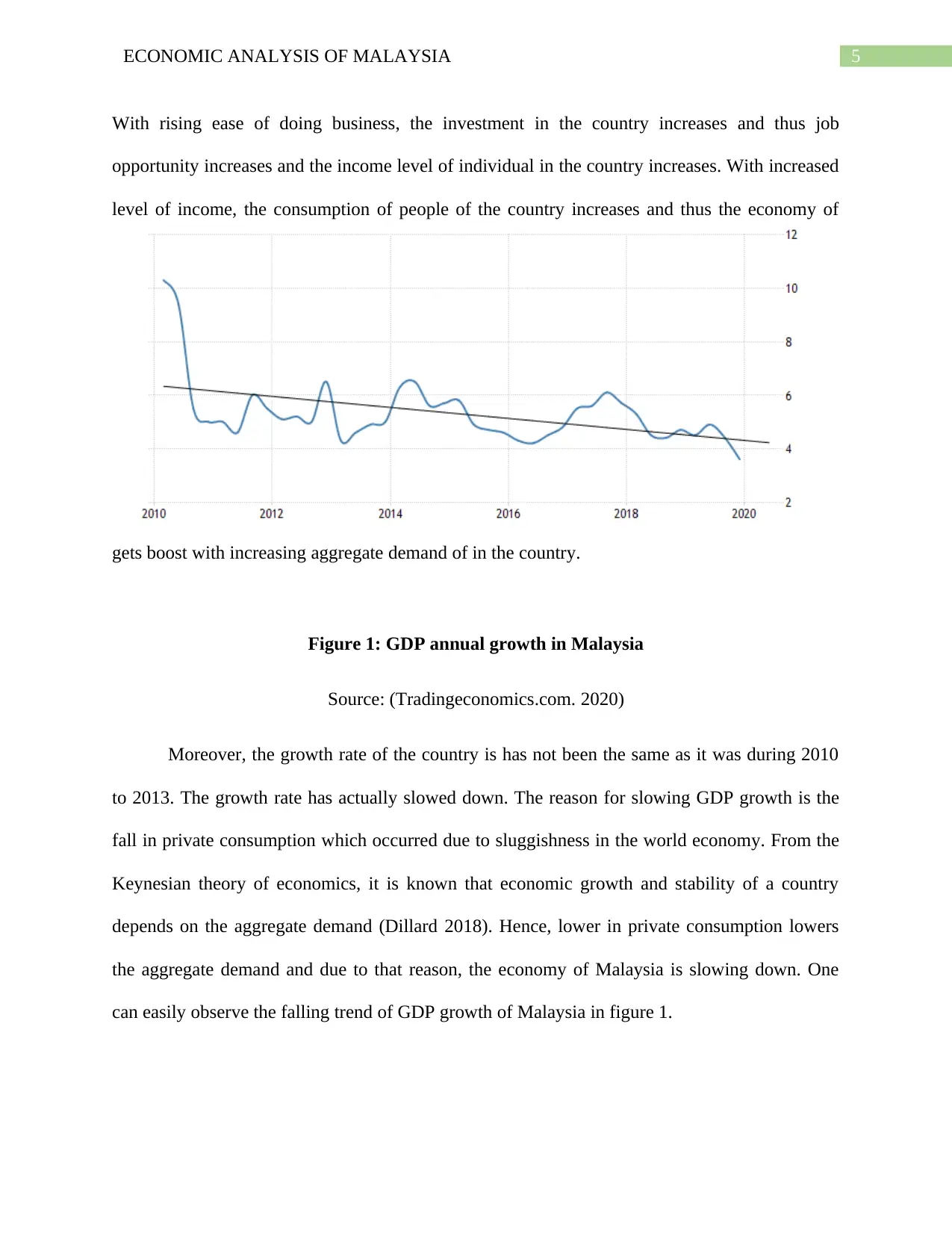
5ECONOMIC ANALYSIS OF MALAYSIA
With rising ease of doing business, the investment in the country increases and thus job
opportunity increases and the income level of individual in the country increases. With increased
level of income, the consumption of people of the country increases and thus the economy of
gets boost with increasing aggregate demand of in the country.
Figure 1: GDP annual growth in Malaysia
Source: (Tradingeconomics.com. 2020)
Moreover, the growth rate of the country is has not been the same as it was during 2010
to 2013. The growth rate has actually slowed down. The reason for slowing GDP growth is the
fall in private consumption which occurred due to sluggishness in the world economy. From the
Keynesian theory of economics, it is known that economic growth and stability of a country
depends on the aggregate demand (Dillard 2018). Hence, lower in private consumption lowers
the aggregate demand and due to that reason, the economy of Malaysia is slowing down. One
can easily observe the falling trend of GDP growth of Malaysia in figure 1.
With rising ease of doing business, the investment in the country increases and thus job
opportunity increases and the income level of individual in the country increases. With increased
level of income, the consumption of people of the country increases and thus the economy of
gets boost with increasing aggregate demand of in the country.
Figure 1: GDP annual growth in Malaysia
Source: (Tradingeconomics.com. 2020)
Moreover, the growth rate of the country is has not been the same as it was during 2010
to 2013. The growth rate has actually slowed down. The reason for slowing GDP growth is the
fall in private consumption which occurred due to sluggishness in the world economy. From the
Keynesian theory of economics, it is known that economic growth and stability of a country
depends on the aggregate demand (Dillard 2018). Hence, lower in private consumption lowers
the aggregate demand and due to that reason, the economy of Malaysia is slowing down. One
can easily observe the falling trend of GDP growth of Malaysia in figure 1.
⊘ This is a preview!⊘
Do you want full access?
Subscribe today to unlock all pages.

Trusted by 1+ million students worldwide
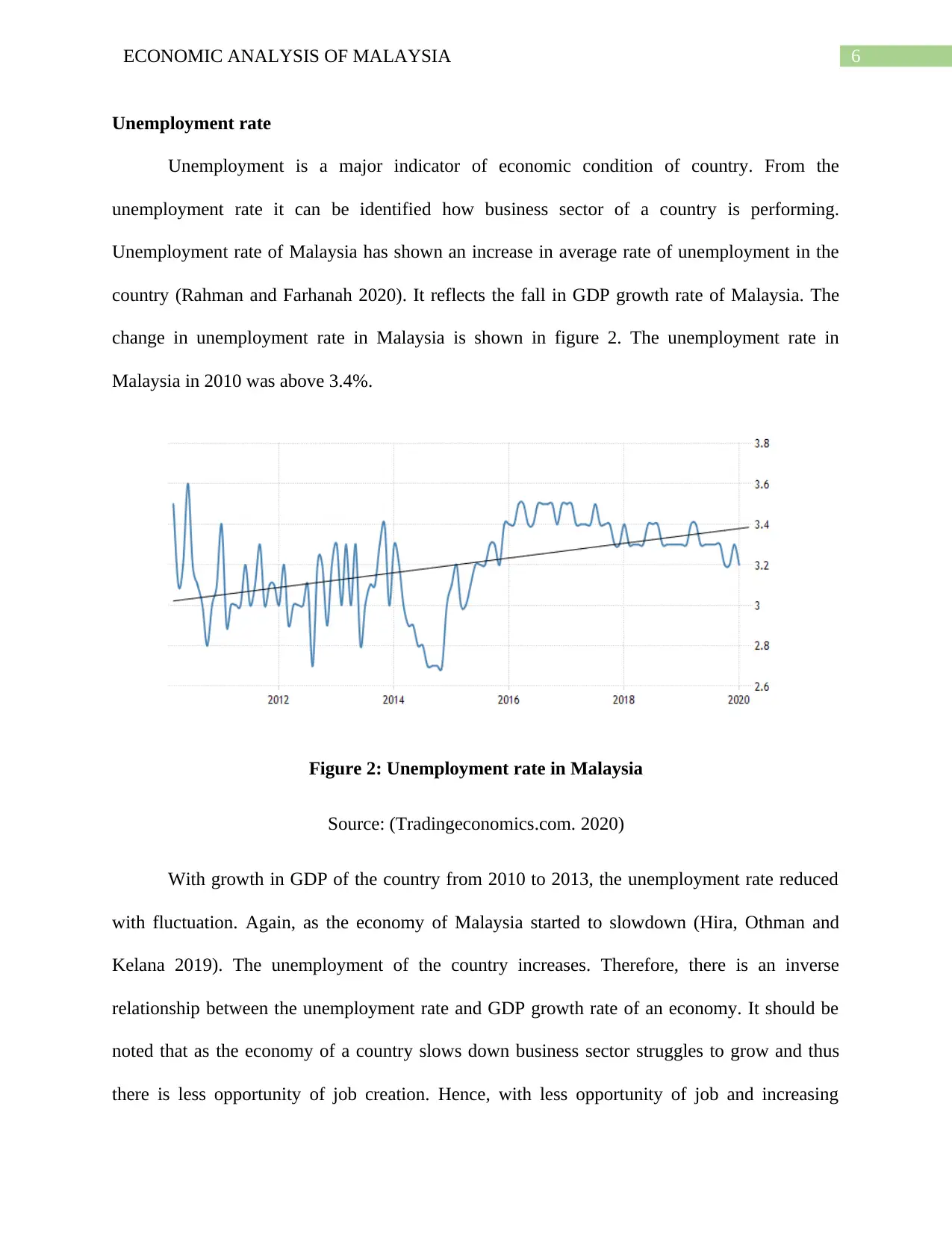
6ECONOMIC ANALYSIS OF MALAYSIA
Unemployment rate
Unemployment is a major indicator of economic condition of country. From the
unemployment rate it can be identified how business sector of a country is performing.
Unemployment rate of Malaysia has shown an increase in average rate of unemployment in the
country (Rahman and Farhanah 2020). It reflects the fall in GDP growth rate of Malaysia. The
change in unemployment rate in Malaysia is shown in figure 2. The unemployment rate in
Malaysia in 2010 was above 3.4%.
Figure 2: Unemployment rate in Malaysia
Source: (Tradingeconomics.com. 2020)
With growth in GDP of the country from 2010 to 2013, the unemployment rate reduced
with fluctuation. Again, as the economy of Malaysia started to slowdown (Hira, Othman and
Kelana 2019). The unemployment of the country increases. Therefore, there is an inverse
relationship between the unemployment rate and GDP growth rate of an economy. It should be
noted that as the economy of a country slows down business sector struggles to grow and thus
there is less opportunity of job creation. Hence, with less opportunity of job and increasing
Unemployment rate
Unemployment is a major indicator of economic condition of country. From the
unemployment rate it can be identified how business sector of a country is performing.
Unemployment rate of Malaysia has shown an increase in average rate of unemployment in the
country (Rahman and Farhanah 2020). It reflects the fall in GDP growth rate of Malaysia. The
change in unemployment rate in Malaysia is shown in figure 2. The unemployment rate in
Malaysia in 2010 was above 3.4%.
Figure 2: Unemployment rate in Malaysia
Source: (Tradingeconomics.com. 2020)
With growth in GDP of the country from 2010 to 2013, the unemployment rate reduced
with fluctuation. Again, as the economy of Malaysia started to slowdown (Hira, Othman and
Kelana 2019). The unemployment of the country increases. Therefore, there is an inverse
relationship between the unemployment rate and GDP growth rate of an economy. It should be
noted that as the economy of a country slows down business sector struggles to grow and thus
there is less opportunity of job creation. Hence, with less opportunity of job and increasing
Paraphrase This Document
Need a fresh take? Get an instant paraphrase of this document with our AI Paraphraser
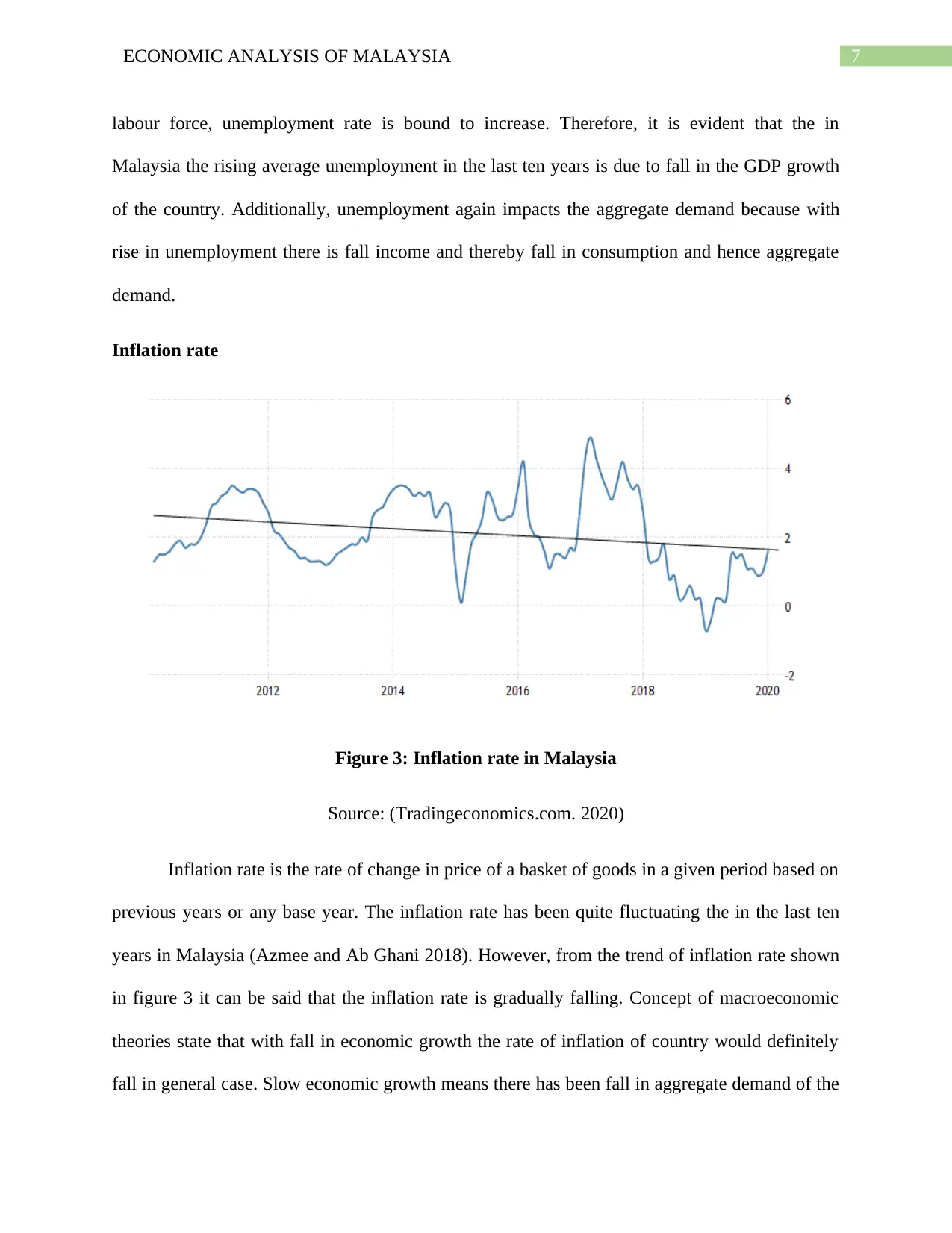
7ECONOMIC ANALYSIS OF MALAYSIA
labour force, unemployment rate is bound to increase. Therefore, it is evident that the in
Malaysia the rising average unemployment in the last ten years is due to fall in the GDP growth
of the country. Additionally, unemployment again impacts the aggregate demand because with
rise in unemployment there is fall income and thereby fall in consumption and hence aggregate
demand.
Inflation rate
Figure 3: Inflation rate in Malaysia
Source: (Tradingeconomics.com. 2020)
Inflation rate is the rate of change in price of a basket of goods in a given period based on
previous years or any base year. The inflation rate has been quite fluctuating the in the last ten
years in Malaysia (Azmee and Ab Ghani 2018). However, from the trend of inflation rate shown
in figure 3 it can be said that the inflation rate is gradually falling. Concept of macroeconomic
theories state that with fall in economic growth the rate of inflation of country would definitely
fall in general case. Slow economic growth means there has been fall in aggregate demand of the
labour force, unemployment rate is bound to increase. Therefore, it is evident that the in
Malaysia the rising average unemployment in the last ten years is due to fall in the GDP growth
of the country. Additionally, unemployment again impacts the aggregate demand because with
rise in unemployment there is fall income and thereby fall in consumption and hence aggregate
demand.
Inflation rate
Figure 3: Inflation rate in Malaysia
Source: (Tradingeconomics.com. 2020)
Inflation rate is the rate of change in price of a basket of goods in a given period based on
previous years or any base year. The inflation rate has been quite fluctuating the in the last ten
years in Malaysia (Azmee and Ab Ghani 2018). However, from the trend of inflation rate shown
in figure 3 it can be said that the inflation rate is gradually falling. Concept of macroeconomic
theories state that with fall in economic growth the rate of inflation of country would definitely
fall in general case. Slow economic growth means there has been fall in aggregate demand of the
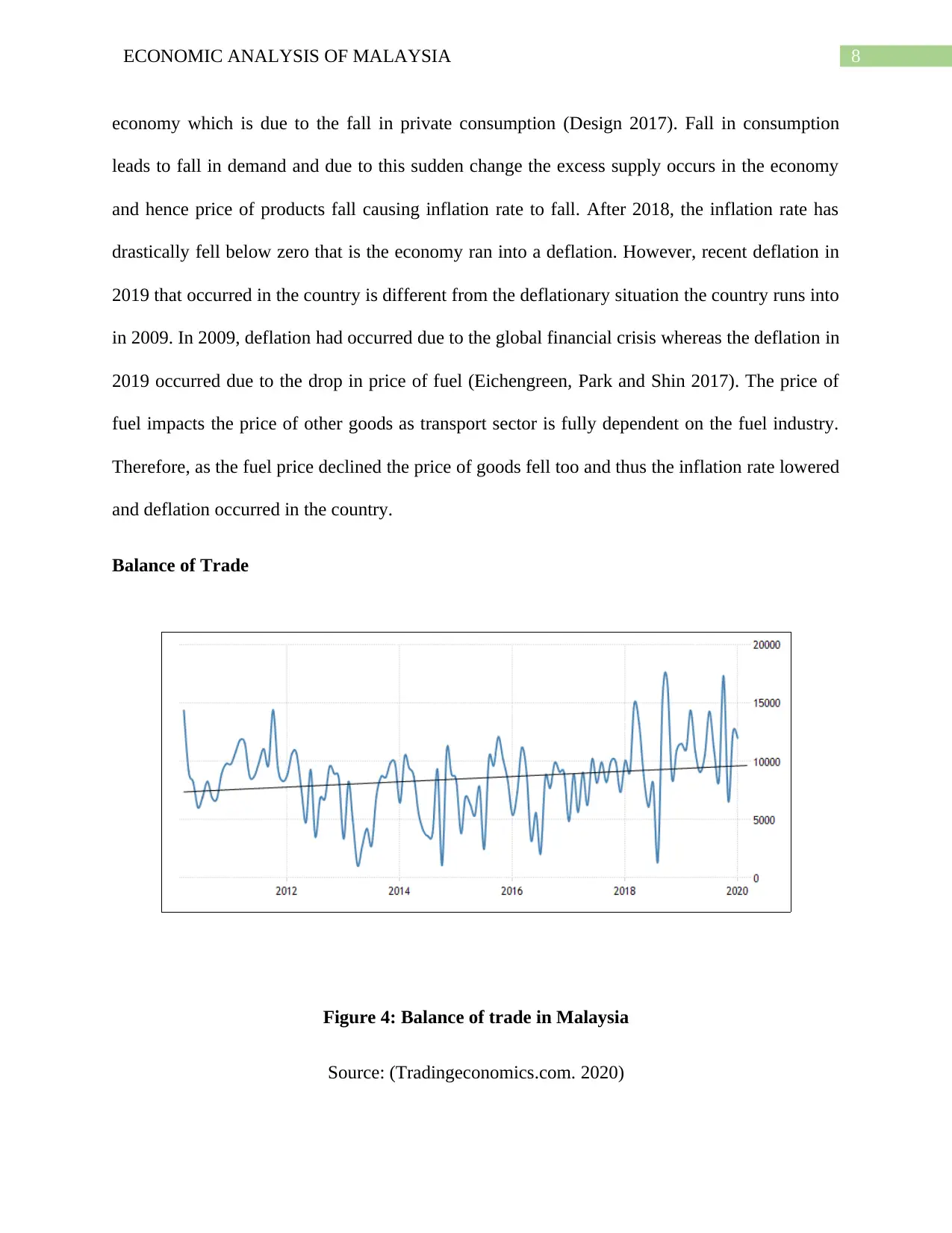
8ECONOMIC ANALYSIS OF MALAYSIA
economy which is due to the fall in private consumption (Design 2017). Fall in consumption
leads to fall in demand and due to this sudden change the excess supply occurs in the economy
and hence price of products fall causing inflation rate to fall. After 2018, the inflation rate has
drastically fell below zero that is the economy ran into a deflation. However, recent deflation in
2019 that occurred in the country is different from the deflationary situation the country runs into
in 2009. In 2009, deflation had occurred due to the global financial crisis whereas the deflation in
2019 occurred due to the drop in price of fuel (Eichengreen, Park and Shin 2017). The price of
fuel impacts the price of other goods as transport sector is fully dependent on the fuel industry.
Therefore, as the fuel price declined the price of goods fell too and thus the inflation rate lowered
and deflation occurred in the country.
Balance of Trade
Figure 4: Balance of trade in Malaysia
Source: (Tradingeconomics.com. 2020)
economy which is due to the fall in private consumption (Design 2017). Fall in consumption
leads to fall in demand and due to this sudden change the excess supply occurs in the economy
and hence price of products fall causing inflation rate to fall. After 2018, the inflation rate has
drastically fell below zero that is the economy ran into a deflation. However, recent deflation in
2019 that occurred in the country is different from the deflationary situation the country runs into
in 2009. In 2009, deflation had occurred due to the global financial crisis whereas the deflation in
2019 occurred due to the drop in price of fuel (Eichengreen, Park and Shin 2017). The price of
fuel impacts the price of other goods as transport sector is fully dependent on the fuel industry.
Therefore, as the fuel price declined the price of goods fell too and thus the inflation rate lowered
and deflation occurred in the country.
Balance of Trade
Figure 4: Balance of trade in Malaysia
Source: (Tradingeconomics.com. 2020)
⊘ This is a preview!⊘
Do you want full access?
Subscribe today to unlock all pages.

Trusted by 1+ million students worldwide
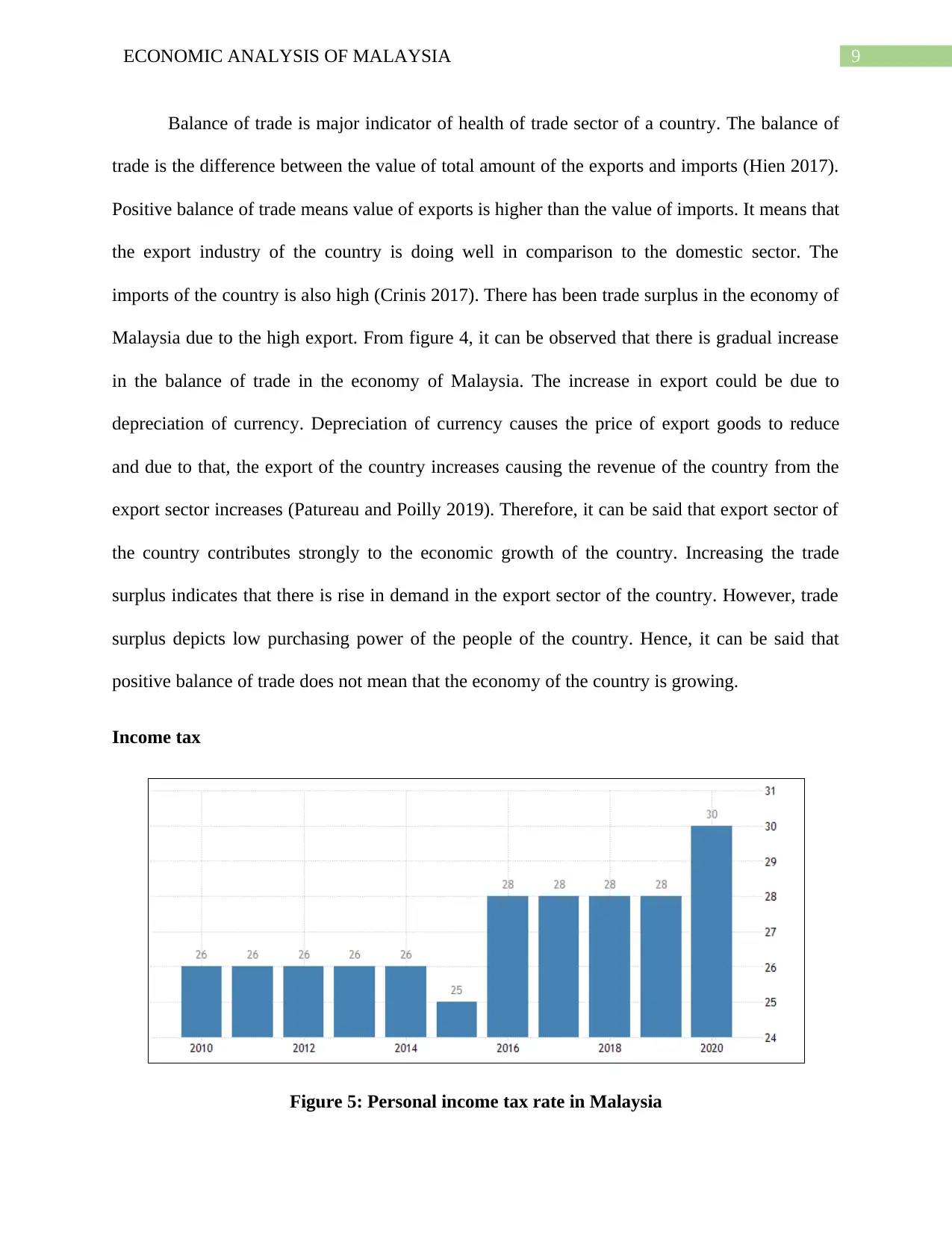
9ECONOMIC ANALYSIS OF MALAYSIA
Balance of trade is major indicator of health of trade sector of a country. The balance of
trade is the difference between the value of total amount of the exports and imports (Hien 2017).
Positive balance of trade means value of exports is higher than the value of imports. It means that
the export industry of the country is doing well in comparison to the domestic sector. The
imports of the country is also high (Crinis 2017). There has been trade surplus in the economy of
Malaysia due to the high export. From figure 4, it can be observed that there is gradual increase
in the balance of trade in the economy of Malaysia. The increase in export could be due to
depreciation of currency. Depreciation of currency causes the price of export goods to reduce
and due to that, the export of the country increases causing the revenue of the country from the
export sector increases (Patureau and Poilly 2019). Therefore, it can be said that export sector of
the country contributes strongly to the economic growth of the country. Increasing the trade
surplus indicates that there is rise in demand in the export sector of the country. However, trade
surplus depicts low purchasing power of the people of the country. Hence, it can be said that
positive balance of trade does not mean that the economy of the country is growing.
Income tax
Figure 5: Personal income tax rate in Malaysia
Balance of trade is major indicator of health of trade sector of a country. The balance of
trade is the difference between the value of total amount of the exports and imports (Hien 2017).
Positive balance of trade means value of exports is higher than the value of imports. It means that
the export industry of the country is doing well in comparison to the domestic sector. The
imports of the country is also high (Crinis 2017). There has been trade surplus in the economy of
Malaysia due to the high export. From figure 4, it can be observed that there is gradual increase
in the balance of trade in the economy of Malaysia. The increase in export could be due to
depreciation of currency. Depreciation of currency causes the price of export goods to reduce
and due to that, the export of the country increases causing the revenue of the country from the
export sector increases (Patureau and Poilly 2019). Therefore, it can be said that export sector of
the country contributes strongly to the economic growth of the country. Increasing the trade
surplus indicates that there is rise in demand in the export sector of the country. However, trade
surplus depicts low purchasing power of the people of the country. Hence, it can be said that
positive balance of trade does not mean that the economy of the country is growing.
Income tax
Figure 5: Personal income tax rate in Malaysia
Paraphrase This Document
Need a fresh take? Get an instant paraphrase of this document with our AI Paraphraser
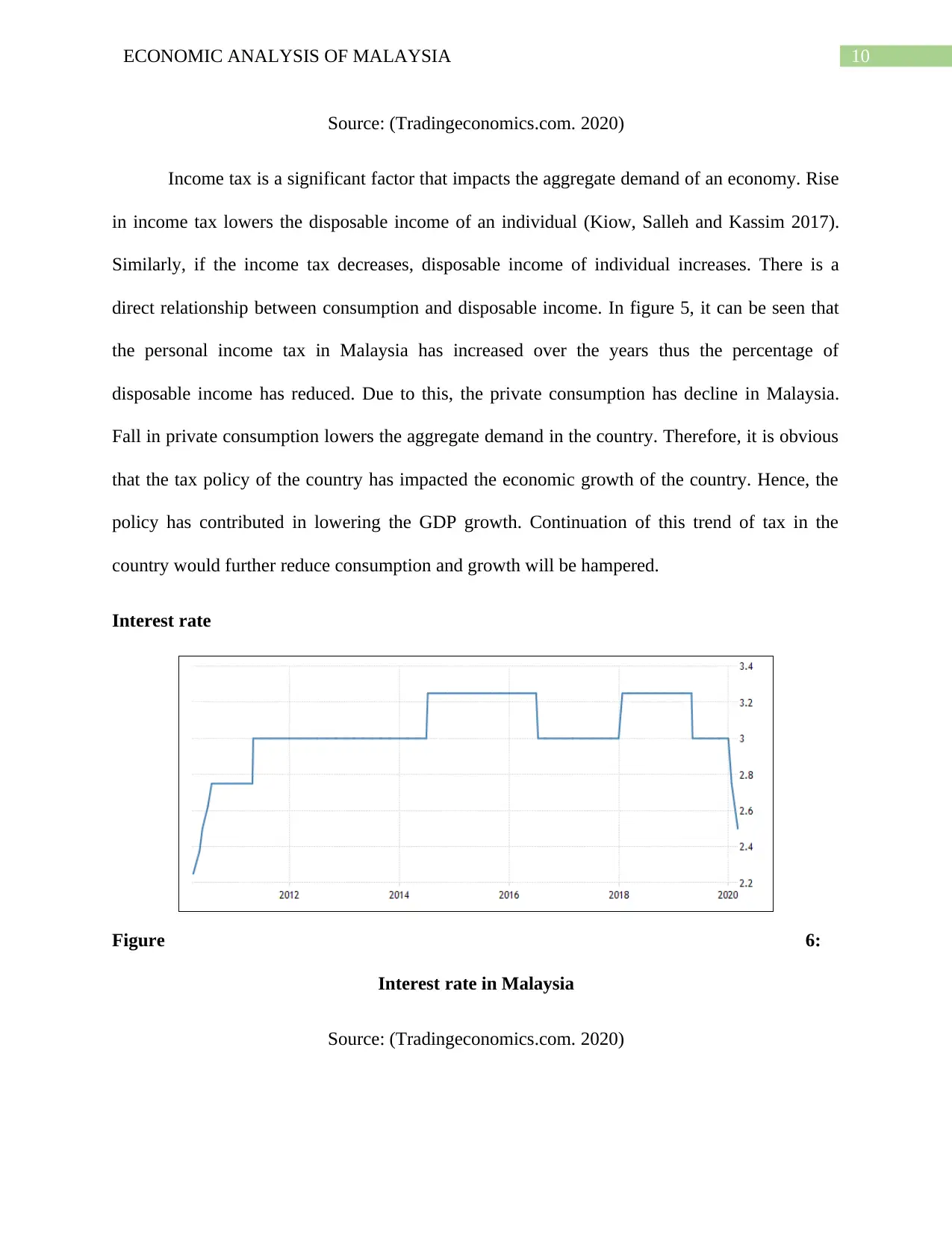
10ECONOMIC ANALYSIS OF MALAYSIA
Source: (Tradingeconomics.com. 2020)
Income tax is a significant factor that impacts the aggregate demand of an economy. Rise
in income tax lowers the disposable income of an individual (Kiow, Salleh and Kassim 2017).
Similarly, if the income tax decreases, disposable income of individual increases. There is a
direct relationship between consumption and disposable income. In figure 5, it can be seen that
the personal income tax in Malaysia has increased over the years thus the percentage of
disposable income has reduced. Due to this, the private consumption has decline in Malaysia.
Fall in private consumption lowers the aggregate demand in the country. Therefore, it is obvious
that the tax policy of the country has impacted the economic growth of the country. Hence, the
policy has contributed in lowering the GDP growth. Continuation of this trend of tax in the
country would further reduce consumption and growth will be hampered.
Interest rate
Figure 6:
Interest rate in Malaysia
Source: (Tradingeconomics.com. 2020)
Source: (Tradingeconomics.com. 2020)
Income tax is a significant factor that impacts the aggregate demand of an economy. Rise
in income tax lowers the disposable income of an individual (Kiow, Salleh and Kassim 2017).
Similarly, if the income tax decreases, disposable income of individual increases. There is a
direct relationship between consumption and disposable income. In figure 5, it can be seen that
the personal income tax in Malaysia has increased over the years thus the percentage of
disposable income has reduced. Due to this, the private consumption has decline in Malaysia.
Fall in private consumption lowers the aggregate demand in the country. Therefore, it is obvious
that the tax policy of the country has impacted the economic growth of the country. Hence, the
policy has contributed in lowering the GDP growth. Continuation of this trend of tax in the
country would further reduce consumption and growth will be hampered.
Interest rate
Figure 6:
Interest rate in Malaysia
Source: (Tradingeconomics.com. 2020)
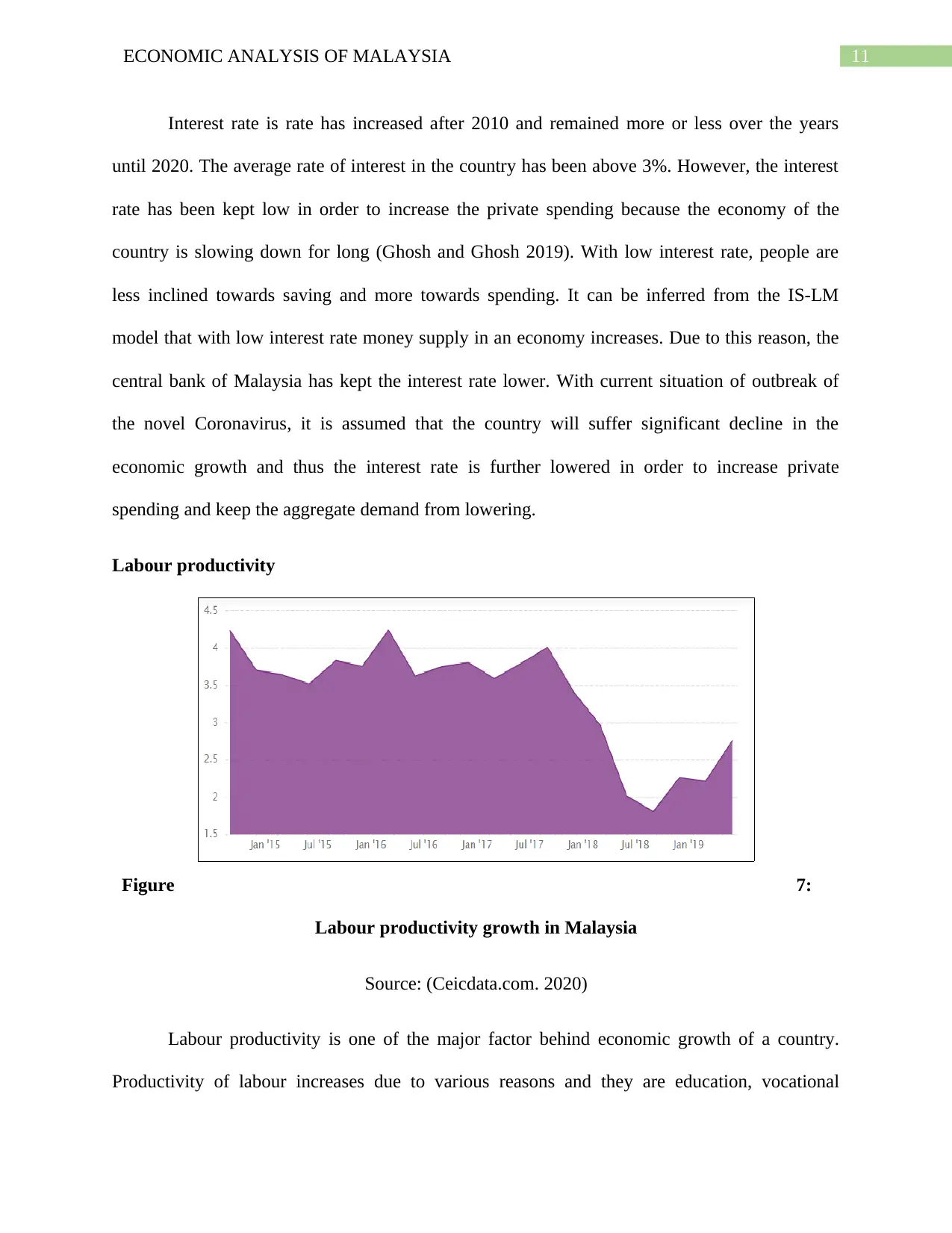
11ECONOMIC ANALYSIS OF MALAYSIA
Interest rate is rate has increased after 2010 and remained more or less over the years
until 2020. The average rate of interest in the country has been above 3%. However, the interest
rate has been kept low in order to increase the private spending because the economy of the
country is slowing down for long (Ghosh and Ghosh 2019). With low interest rate, people are
less inclined towards saving and more towards spending. It can be inferred from the IS-LM
model that with low interest rate money supply in an economy increases. Due to this reason, the
central bank of Malaysia has kept the interest rate lower. With current situation of outbreak of
the novel Coronavirus, it is assumed that the country will suffer significant decline in the
economic growth and thus the interest rate is further lowered in order to increase private
spending and keep the aggregate demand from lowering.
Labour productivity
Figure 7:
Labour productivity growth in Malaysia
Source: (Ceicdata.com. 2020)
Labour productivity is one of the major factor behind economic growth of a country.
Productivity of labour increases due to various reasons and they are education, vocational
Interest rate is rate has increased after 2010 and remained more or less over the years
until 2020. The average rate of interest in the country has been above 3%. However, the interest
rate has been kept low in order to increase the private spending because the economy of the
country is slowing down for long (Ghosh and Ghosh 2019). With low interest rate, people are
less inclined towards saving and more towards spending. It can be inferred from the IS-LM
model that with low interest rate money supply in an economy increases. Due to this reason, the
central bank of Malaysia has kept the interest rate lower. With current situation of outbreak of
the novel Coronavirus, it is assumed that the country will suffer significant decline in the
economic growth and thus the interest rate is further lowered in order to increase private
spending and keep the aggregate demand from lowering.
Labour productivity
Figure 7:
Labour productivity growth in Malaysia
Source: (Ceicdata.com. 2020)
Labour productivity is one of the major factor behind economic growth of a country.
Productivity of labour increases due to various reasons and they are education, vocational
⊘ This is a preview!⊘
Do you want full access?
Subscribe today to unlock all pages.

Trusted by 1+ million students worldwide
1 out of 19
Related Documents
Your All-in-One AI-Powered Toolkit for Academic Success.
+13062052269
info@desklib.com
Available 24*7 on WhatsApp / Email
![[object Object]](/_next/static/media/star-bottom.7253800d.svg)
Unlock your academic potential
Copyright © 2020–2025 A2Z Services. All Rights Reserved. Developed and managed by ZUCOL.





